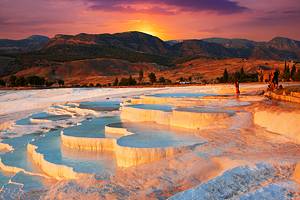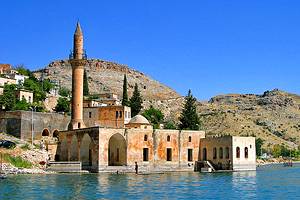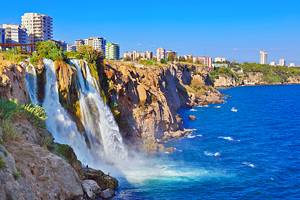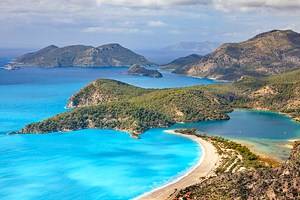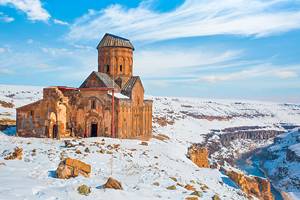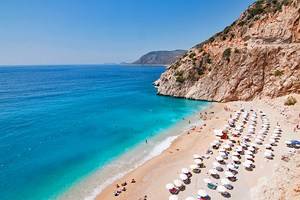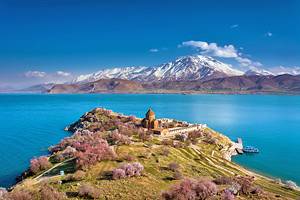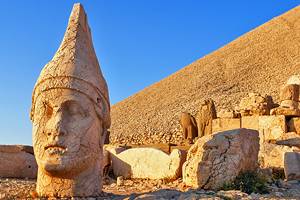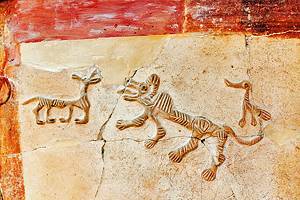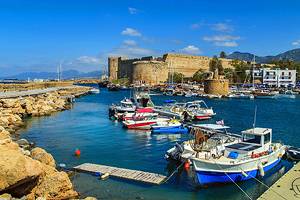Things to Do in Adana, Turkey
Turkey's sixth largest city, Adana sits beside the snaking Seyhan River and is surrounded by the rolling hills of the Çukurova region, made famous in Yaşar Kemal's classic novel Memed, My Hawk.

It's best known as home to Turkey's Adana kebab, and foodies will probably put sampling this dish in the city's restaurants at the top of their things to do list while in town. This city, though, has much more to offer travelers.
The hinterland is scattered with archaeological sites and historic tourist attractions, making Adana one of the best places to visit and base yourself. From here, you can head out and sightsee in Turkey's eastern Mediterranean region.
From neo-Hittite sites and Roman ruins to a crumbling castle remnant from this area's Armenian Kingdom of Cilicia, Adana has a multitude of monuments within day-tripping distance.
Adana has good bus connections with Cappadocia (258 kilometers to Adana's north) and Konya (346 kilometers northwest), and there's also a highly scenic train line between Konya and Adana, making the city an easy add-on trip from either of these two inland Turkey highlights.
Help plan your visit with our list of the top things to do in Adana.
- Explore Adana's Heritage Buildings
- Visit the Sabancı Merkez Mosque
- Scramble Up to Yılankale
- Discover Turkey's Hittite Past at Karatepe-Aslantaş Open-Air Museum
- Explore Kastabala
- Delve into the Ruins of Anazarva
- View the Varda Viaduct
- Visit Adana's Archaeology Museum
- Day Trip to Tarsus
- Discover Kızkalesi's Glut of Ruins
- Head Underground at the Caves of Heaven & Hell
- Stroll through the Uzuncaburç Ruins
- Adana, Turkey - Climate Chart
Explore Adana's Heritage Buildings

Adana is a sprawling city but within its old central district, beside the Seyhan River, you'll find a number of buildings and monuments dating from before the modern building boom.
The Roman-built, 21-arched Stone Bridge (Taşköprü) spanning the river is the area's most famous landmark.
After strolling the bridge - from where you can get great photos of the Sabancı Merkez Mosque - head west into the central district to visit the 16th-century Ulu Cami (Grand Mosque) with its tiled mihrab (prayer niche).
Just behind the Ulu Cami (Grand Mosque), you'll find the Ramazanoğlu Medrese, where you can now sip tea in the leafy courtyard café of this old theological college.
Just to the south is Adana's skinny 19th-century clock tower. Walk west from here to the Yağ Cami (Oil Mosque), set in a converted church building, which dates from the Crusader period.
Visit the Sabancı Merkez Mosque

The most recognizable building in town is this massive modern mosque, set within manicured gardens on the bank of the Seyhan River.
Built in 1998, the mosque can hold over 28,000 worshippers and is thought to be one of the largest in the entire Middle East.
The six minarets rimming the prayer hall soar to 99 meters high.
Inside, under the mammoth 54 meter-high dome, the interior strictly follows Ottoman design using Iznik tiles and traditional calligraphy features to decorate the prayer hall.
The mosque is open for non-Muslim visitors outside of prayer times.
For the most impressive photos of the façade, head south from the mosque, down the river bank to the Stone Bridge.
Address: Turhan Cemal Beriker Caddesi
Scramble Up to Yılankale

Yılankale (Snake Castle) is an Armenian-built fortress, with its crenellated battlements and towers still trailing across a high limestone ridge, 47 kilometers east of Adana.
Built in the 12th century, Yılankale was part of the defensive line for the Armenian Kingdom of Cilicia, which controlled this stretch of coast from modern-day Alanya down to Iskenderun in the late medieval era.
The castle's exterior features of ramparts, bulging defensive towers, and gatehouses are well preserved and can be walked on for commanding views across the surrounding countryside. It's a steep, rocky trail from the entrance to reach them, so wear good walking shoes.
Most of the interior features of the castle lay in ruins though those willing to scramble up to the higher reaches of the site can explore vaulted chambers and the castle's cisterns.
In local folklore, the castle is said to be home to the Anatolian mythological serpent woman Şahmaran.
Discover Turkey's Hittite Past at Karatepe-Aslantaş Open-Air Museum

This tranquil open-air museum, 126 kilometers northeast from Adana, is home to one of the most important neo-Hittite (from 700 BCE) sites in Turkey.
Set in thick pine forest bordering the Aslantaş Dam, Karatepe-Aslantaş was where the neo-Hittite ruler Asativatas built his Asativataya Fortress and graced it with statuary of lions and sphinxes and stone orthostats portraying finely detailed scenes and inscriptions.
After the collapse of Anatolia's Bronze Age Hittite Empire, several small pockets of Hittite rule remained and continued to evolve independently. Karatepe-Aslantaş dates from this tumultuous era.
Today the most prominent features of the fortress building left are the squat exterior battlements, which trace the shape of the structure. Archaeological work inside this area during the 1940s and 1950s uncovered the carved stone decoration that made Karatepe-Aslantaş famous.
Unlike other sites, though, the stonework here has been kept on-site rather than transferred to museums and is now displayed at various points along forested trails within the fortress area.
Explore Kastabala

If you're heading to Karatepe-Aslantaş, stop off at Kastabala along the way.
Sitting just 18 kilometers south, on the main road to the neo-Hittite site, Ancient Kastabala was originally part of the local neo-Hittite kingdom, but the ruins you see today date from the much later Greco-Roman and Byzantine periods.
A long, overgrown, colonnaded street with re-raised columns leads past a Byzantine bathhouse to the remains of a Roman temple and small theater.
The ruins are overlooked by a castle, built during the medieval era, which sits atop the hill behind.
The castle is built over the city's Roman-era acropolis area, and if you scramble up the hill, you can view classical-era tombs chiseled into the rock.
Delve into the Ruins of Anazarva

The sleepy rural village of Dilekkaya, 80 kilometers northeast from Adana, is littered with the remains of Ancient Anazarva (also known as Anazarbus) and backed by a high cliff topped by Anazarva Castle.
Head to the castle first, which is reached by puffing up a series of steep staircases cut into the cliff. The farther reaches of the castle ramparts and battlements, which trails the full length of the cliff, are out of bounds due to safety issues but there's plenty still to explore on the cliff top.
Back down, on the plain below, the fields amid the village are scattered with ruins, including a Roman-era aqueduct, a grand gateway, and a Byzantine church dating from the 6th century.
Anazarva was a prominent city for this region in the Roman era, and despite devastating earthquakes and tumultuous changes in regional power over the centuries, it continued to be important until Egypt's Mamluk army invaded and destroyed the city in the 14th century.
A day trip here is easily combined with a visit to Yılankale.
View the Varda Viaduct

The Varda Viaduct (Varda Köprüsü), stretching across the deep gorge of Çakıt Deresi, was built to facilitate the Ottoman Istanbul-Baghdad railway line, though today it's more famous for its starring role in the James Bond film Skyfall.
The 172-meters-long bridge is graced by eleven stone arches, which sit 98 meters above the canyon's lowest depth.
If you want to travel across the viaduct, hop on the Toros Express train, which runs daily between Adana and Konya. As the railway line passes through the Taurus Mountains, it's a dramatically scenic journey between the two cities.
To visit the viaduct, head northwest from Adana city for 52 kilometers, through the province's agricultural heartland, to the village of Karaisalı and then follow the signs from here for a farther 18 kilometers to the bridge.
There are a couple of cafés situated on the lip of the gorge, which offer panoramic lookout points across to the viaduct.
Visit Adana's Archaeology Museum

Adana's exceptional new museum is housed in a repurposed textile factory and displays a wealth of artifacts that all hail from the local area, showcasing the history and heritage of the surrounding area.
The collection ranges from the Neolithic right up to the Ottoman era and is particularly impressive in its Bronze Age Hittite period exhibits, with plentiful orthostats and stone statuary, and its Classical-era displays that range from glasswork and ceramics to columns and capitals.
Don't miss the mosaic hall with its striking Roman and Byzantine mosaic floors, including the famed "Noah's Ark" mosaic from Ancient Misis.
Excellent information boards throughout the museum aid the visitor experience, allowing even casual visitors with little prior knowledge to get to grips with the deep history of this region.
Address: Ahmet Cevdet Yağ Bulvarı 7, Adana
Day Trip to Tarsus

Just 42 kilometers west of Adana, Tarsus makes for an easy day-trip destination from the city.
This is where Saul of Tarsus (who later became St. Paul) was born and brought up, and there's a handful of Christian pilgrimage sites secreted within the central old city's alleys.
The old city district itself, with its cobblestone alleys crammed with creaky Ottoman houses slouching into various states of dilapidation, is worth a visit alone. Here, you'll also find a stretch of Roman-era road, running for 60 meters, which has been unearthed and preserved.
While in the old city neighborhood, make sure to visit the Eski Cami (Old Mosque), which was converted from an earlier 12th-century church that was dedicated to St. Paul.
For Christian visitors though, the main attraction in town is St. Paul's Well on Hal Caddesi. The excavated house ruins of what some say was St. Paul's home are displayed in the well's courtyard. Although there is little to see, it's an important pilgrimage site.
Christian visitors will also appreciate a visit to the modern (built in 1850), Greek Orthodox Church of St. Paul on Abdı Ipekçi Caddesi, known today as the St. Paul Memorial Museum.
Discover Kızkalesi's Glut of Ruins

Kızkalesi is a beach resort, 144 kilometers southwest from Adana, favored by domestic visitors and Scandinavian tourists during the long summer beach season.
Although most people are here to flop on the strip of shingle and sand that rims the town, the Kızkalesi area is packed with historical sites, and a day of hopping between its Greco-Roman ruins makes for one of the best day-trips from Adana.
The two most famous landmarks are the castles. Corycus Castle marks the northern end of Kızkalesi beach, while just offshore, commanding the shore view, is Kızkalesi Castle, reached by regular boat trips shuttling to and from the beach.
The countryside around Kızkalesi is known as the Olba Plateau and is littered with ruins.
Roughly four kilometers before you reach town, coming from Adana, the remnants of Elaiussa Sebaste lie scattered beside the highway. Scramble up to the Roman theater, cut into the hillside, before exploring the Byzantine church and the Roman Agora with its preserved mosaics, below.
In the hills to the north of Kızkalesi is the Roman necropolis of Adamkayalar. The site holds plenty of tumbled tomb monuments, but it is most famous for its carved cliff side reliefs commemorating the dead, dating from the 1st century CE.
Head Underground at the Caves of Heaven & Hell

The tiny cove of Narlıkuyu sits four kilometers west from Kızkalesi (148 kilometers southwest from Adana) and is known for its fish restaurants with their outdoor balconies jutting out over the sea.
Just two kilometers heading inland up the steep hill from the cove are the Caves of Heaven and Hell (Cennet Cehenem Mağarası), which, according to legend, connect with the underworld's River Styx.
The Cave of Hell is where the monster Typhon was captured by Zeus, according to Greek mythology. The dizzying 130-meter-deep sinkhole is viewed today from a platform that juts out over the chasm. You'll need a good head for heights to peer down into the depths from the barrier.
The Cave of Heaven is reached by walking down a series of steep staircases (over 400 steps) to where a Byzantine-era church sits at the yawning mouth of the cave.
The chasm stretches back for 250 meters and is 70 meters deep, with a walkway and lights along the way. It can be extremely slippery inside the cave, so you need to wear good walking shoes.
After you've explored the caves, head back down the hill to Narlıkuyu for lunch. The little cove's fish restaurants are the most scenic dining options in the Kızkalesi area.
Stroll through the Uzuncaburç Ruins

The hill country northwest of Kızkalesi makes for a scenic road trip brimming with rural vistas, scattered with sleepy villages, and speckled with ancient ruins.
The most famous ruin site here sits amid the village of Uzuncaburç, where a Roman theater backs right up to a house, and a colonnaded street cuts through the middle of town.
This is the site of the Hellenistic city of Olba, which became Diocaesarea in the Roman period.
In the middle of the village, you can walk the colonnaded street to the columns of the Temple of Zeus and then scramble up the Roman theater for great views across the plains below.
Just on the edge of the village is a Hellenistic watch tower, five stories high.
Head east out of the village for four kilometers to get to the impressive aqueduct of Ancient Olba straddling the length of a gorge. The aqueduct is partially destroyed, with some of the tall arches now standing disconnected from the rest of the structure. The cliffs on both sides of the gorge are chiseled with Roman tombs.
Adana, Turkey - Climate Chart
| Average minimum and maximum temperatures for Adana, Turkey in °C | |||||||||||
| J | F | M | A | M | J | J | A | S | O | N | D |
| 15 6 | 15 6 | 18 9 | 21 12 | 24 16 | 28 20 | 30 23 | 31 23 | 30 20 | 26 15 | 21 11 | 16 7 |
| PlanetWare.com | |||||||||||
| Average monthly precipitation totals for Adana, Turkey in mm. | |||||||||||
| 119 | 112 | 58 | 36 | 23 | 8 | 13 | 5 | 10 | 41 | 76 | 135 |
| Average minimum and maximum temperatures for Adana, Turkey in °F | |||||||||||
| J | F | M | A | M | J | J | A | S | O | N | D |
| 58 41 | 59 43 | 64 47 | 70 53 | 75 60 | 81 67 | 86 73 | 87 73 | 85 67 | 79 59 | 70 50 | 61 45 |
| PlanetWare.com | |||||||||||
| Average monthly precipitation totals for Adana, Turkey in inches. | |||||||||||
| 4.7 | 4.4 | 2.3 | 1.4 | 0.9 | 0.3 | 0.5 | 0.2 | 0.4 | 1.6 | 3.0 | 5.3 |



